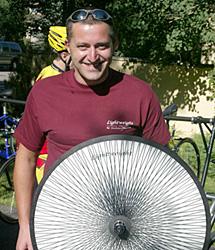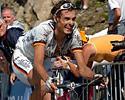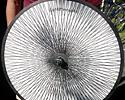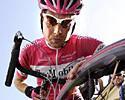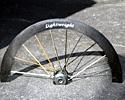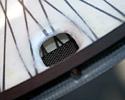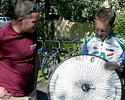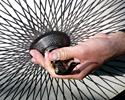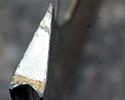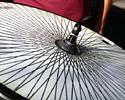
Recently on Cyclingnews.com |
An interview with Stefan Behrens, Lightweight wheel maker, August 16, 2005The man with (carbon) fiber in his diet
Stefan Behrens is the head of CarbonSports GmbH, maker of perhaps the most sought-after wheels in the professional peloton: Lightweight. Since first appearing in the 1990s, Lightweight wheels have popped up all, often under riders sponsored to use someone else's wheels, and almost always paid for out of the rider's own pocket. Cyclingnews' North American Editor, Mark Zalewski sat down with Stefan Behrens to discuss his latest wheels and the role Lightweight Wheels plays in professional cycling. Lightweight Wheels first appeared in the pro peloton in 1995, when company founders Rudolf Dierl and Heinz Obermayer branched out from the disc wheels they had previously made as 'Ultec'. They quickly became a hit and have been used by riders such as Mario Cipollini, Bjarne Riis, Jan Ullrich, Johan Museeuw, Lance Armstrong, Marco Pantani, Stefano Garzelli, and Joseba Beloki. And most of these riders had to obtain their wheels the same way you and I would, by plunking down the US$3,000+ price for a pair of wheels -- probably one of the biggest compliments and endorsements possible for a product. Of course, the wheel companies sponsoring these riders' teams were not happy to see their large investments were being wasted. Most looked the other way while their top riders rode unmarked Lightweights to top finishes, but in the past year, sponsors have gotten more demanding of their agreements, and only Jan Ullrich was seen riding these ultra-stiff and ultra-light wheels in the Tour de France. (Ullrich is reported to have a clause in his contract that exempts him from using the sponsors' equipment if he believes something else is better. As of yesterday, Ullrich is campaigning the Tour of Germany on the company's newest creation -- a low-profile wheel set called the Mont Ventoux for their improved performance in crosswind situations. We kicked off by asking Stefan Behrens, whose company bought Lightweight Wheels in 2003, retaining Obermayer as a consultant while Dierl retired, what was new in Cyclingnews: Tell us about the latest developments for your company and product lines? Stefan Behrens: We are expanding and we are going to a lot of different countries, like Italy. We started already in Austria, Switzerland, Belgium and the U.K. The newest thing this year is our new wheel we will present at the Eurobike show, our low-profile wheel. Lots of riders complain that in heavy crosswinds the wheels are so light and the rim is so wide. Riders have always wanted it and so we developed it and because it is low-profile it is even lighter than the wheels we are building now. We are trying to make every low-profile wheel set under 950g a pair and aiming for less than 920g. They will be 25mm and be stronger than the Obermayer because we are building them with twenty spokes in the front and rear. They are bonded together like the other wheels we have. We already have UCI approval for them and Jan Ullrich will be riding them in the Tour of Germany. We changed a little on the disc wheel -- we are not painting them anymore so that cuts down the weight to about 900g for a disc in 700c. We did a few more projects like building spoke wheels for handcycles and we have made track wheels. We are starting track wheel production this fall, CN: Do you see track as your next area of expansion and development? SB: Yes, we built ten sets and some really good riders, some world champions, already tested them and found they were great. CN: In regards to your competitors in the wheel business, have you see more resistance from other manufacturers because your wheels are being used by riders sponsored by these competitors? SB: We are not seeing the resistance [directly], but we can feel it. In the past years there were always a few riders that were riding them. They didn't ask the sponsors and nobody said anything about it. Last year the complete T-Mobile team was riding them in the mountain stages, and Christoph Moreau as well as riders from Gerolsteiner. This year you saw only Jan Ullrich, so there must be something about them! The riders would still like to race the wheels, but if the riders are under contract and the sponsor doesn't want to, we cannot help it. CN: Does your company have any plans on sponsoring teams or riders in the future? SB: Not right now, we are way too small for that. Production and money are the issues. CN: Along those lines, do you want to keep the company small like this or try to grow to meet demand? SB: We will always be small because these wheels demand a lot of handwork. These wheels require eighteen hours of handwork per set. We need really good workers for that -- not anyone can work on a wheel set. So expansion is really limited. We cannot go to any other carbon manufacturers, like in the far east, because the construction of the wheel is the biggest secret. We have to keep it in our own hands. CN: What kind of obstacles does your size present and how do you overcome them? SB: Since we are too small to sponsor a team, it is not as easy for us to get a new product in a new market like the U.S. When you look at Campagnolo and the new Fulcrum wheels, they came from nowhere and they are advertising worldwide and they sponsor like three or four teams. So Fulcrums are a well known product overnight. But it is not really a disadvantage because as we are expanding and going into new markets, the demand is growing from itself. We are now making about ten times the amount of wheels as two years ago and we still have delivery times around seven months. So every importer has a delivery plan for one year. So from that we can see this is not a disadvantage. CN: What about other carbon product lines? Are there plans to make any other components? SB: Well, we make a triathlon carbon frame which we have made for a long time. But we will concentrate on wheels because they are the parts where our expertise is known. We will stick to wheels and maybe go for different versions in the future. We already have some plans but I cannot tell you everything. CN: In your dealings with pro cyclists, what have you noticed is the most coveted attribute of your wheels for them? SB: As far as I have experienced, the pros like the stiffness the most. Of course they like that they are very light and aero, but they don't care about the weight as much as some hobby riders do. They don't care if the set is 1100g or 1080g. They don't put them on the scale. When we sell to a hobby rider he will immediately put them on the scale. No pro rider will do that. All pro riders want the stiffness. CN: Who is your favorite rider? SB: My favorite rider is Jan Ullrich, of course! (laughs) I know him and I have visited him at home. Well, maybe I have two favorite riders because I like Erik Zabel -- and I think it is really amazing that as a sprinter Erik prefers to ride Lightweights because other low-weight wheels won't be stiff enough for a sprinter, and Erik even used the special prototype set with only a twelve spoke front and sixteen spoke rear in last year's Milan-San Remo, superlight under 1000g, and he almost won! Following our conversation, Stefan showed me their new disc wheel, which looks like it has complex artwork -- but in fact the lines are not cosmetic at all. They are carbon reinforcement strips giving the wheel stiffness. These wheels are finding increased use in Ironman Triathalons as well as in time trials and on the track. Stefan then offered me an opportunity to ride a pair of Obermayers -- and all I could think after my first pedal strokes was, "What can I sell on eBay to raise $3,400?" [Offers for one of Mr Zalewski's kidneys should be sent to tech@cyclingnews.com - Ed.] |

